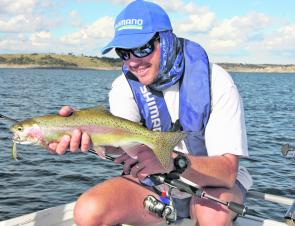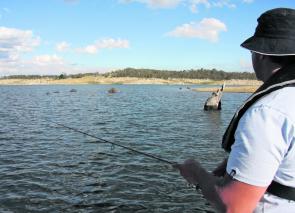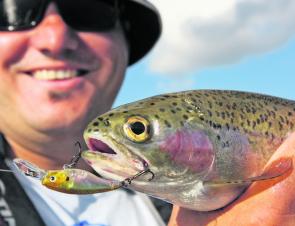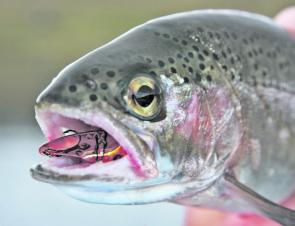Trout are fantastic targets for the sport-fishing enthusiast, able to be taken by many techniques and fishing styles.
I allocate most of my spare time to chasing bream on my home waters on the South Coast but I enjoy the change of pace when I head for the alpine lakes. I like launching my boat and employing many of the techniques and strategies I would use fishing for bream. I also use the same rods, reels and lures.
The most productive way to find feeding trout is to use your electric motor to patrol the contours of the shoreline. Cast towards the bank and slowly roll your lure back to the boat.
This method allows you to present a manner of offerings around and among the fringing weed beds, while covering various depths to determine what depth is optimal on the day.
Water depth slightly either side of 1.5m is a good starting point. Trout can be found extremely tight to the bank in surprisingly shallow water, so do not hesitate to fire a shallow-running minnow towards these skinny margins.
Quite often, the trout’s food source will aggregate in such areas so it makes sense to work them vigilantly.
I particularly enjoy poking into a quiet bay or cove, especially if it is shallow. I work the water that lies in the main basin of the cove before pushing farther into it, positioning the boat so I can fan casts all around. I repeat this process methodically until I have hooked a fish or that I am satisfied the area is void of feeding activity.
If a fish is hooked, it is definitely worth spending a little more time prospecting the general area because foraging fish will continue to mooch into a fertile feeding zone.
It is common to pull multiple fish from one small area, once that feeding zone has been located.
Another area to look for is a grassy point that protrudes from the main shoreline. These areas will be shallow enough to hold aquatic insects, which make up the bulk of the trout’s diet. Yet they are fringed by deeper water, offering the trout shelter and the cooler water they prefer.
Station your boat adjacent to these points and make casts toward the point, then crank your lure over the drop-offs into open water. Trout cruise these fringes, so you are a good chance of picking up a few fish provided your stealth tactics are up to scratch.
Steep banks lined with timber and boulders can be good places to prospect for larger trout. Steep banks lend themselves to deep-diving crankbaits but probing these depths may not be as productive as working the shallows where feeding fish are most active.
In the technique known as a slow roll, simply cast your lure and then slowly wind it back. Do not bother with twitching and jerking your lure, simply crank it and wait for a trout to climb on.
If you get a bump and miss from a curious trout, it is beneficial to incorporate a small pause, then continue slow rolling the lure to entice a full-blooded strike.
All your standard bream lures work, such as minnows, shads and crankbaits. You may have to vary your lure selection to avoid them diving into sub-surface obstacles such as thistles and tussock grass.
Another great option for fishing shallow water is to cast and crank blades or vibes. These are extremely versatile lures, enabling the angler to cover the entire water column with the bonus of sending out vibrations which trout cannot resist. You can also cast them a country mile, covering plenty of water.
The only trick to fishing blades and vibes in shallow water is to start cranking line back onto the reel before the blade touches down to avoid it sinking into the weed or flooded grass. Keep a high rod tip during the early retrieve to ensure the blade rides above sub-surface debris.
I can see blades becoming the go-to lure in all circumstances for trout in years to come.
A 1-4kg spin rod of 7’ or longer with a parabolic action is ideal. It needs enough guts to fire a long cast but a soft action when fighting trout, which are masters at throwing hooks. Nylon or fluorocarbon line reduces pulled hooks because it stretches, helping to hold the hooks in place and providing a shock absorber.
A 1000 size spin reel is comfortable but a 2500 will cast farther, especially with monofilament line. Braid of 2-4lb should be tied to a leader of 4-6lb fluorocarbon, while the mono main line should be around 4lb to obtain long casts.
Ensure your hooks are sharp.
Recent rain or seasonal snowmelt can cause the lakes to flood, opening up new real estate to the mooching trout.
Rising water turns inundated grassland into a smorgasbord of worms, beetles and grubs. Flat paddocks transform into shallow basins laden with tussocks, thistles and timber debris.
These areas also become fertile breeding grounds for amphibians, aquatic beetles, and insects, which also become tasty meals for trout.
These scenarios most commonly occur in late Spring to early Summer.
If your trip to the mountains coincides with rising or high barometric pressure, it is possible to score amazing results. Keep an eye on the dam levels page in NSWFM or visit www.snowyhydro.com.au.
Alternatively, call your favourite accommodation provider for a precise reading and make a booking. At this time of year the snow crowds have gone and you’ll make big savings. I like Buckenderra Holiday Village at Eucumbene but at this time of year all the alpine lakes will fish very well – better than the streams on opening weekend.
Trailer boat access is always good, even when the lake water level is low, and an abundance of highly accessible shoreline is available to the land-based angler. Freshwater fishing is a nice change of pace for us saltwater locals, and it is a bonus not having to flush the motor and wash the gear down.
Reads: 2147
The author pulled this feisty rainbow on a Strike Pro Smelta cranked along the edge of a shallow point.

Points that protrude from the shore can be highly productive and definitely worth prospecting.

Originally designed as a Japanese trout lure, the Ecogear SX40 is a favourite bream lure in this country but works on Aussie trout. All your bream lures should.

Check where this TT Ghost Blade ended up as this rainbow homed in on the vibration.

Another fine trout finds the vibrating call of a slowly rolled blade irresistible. Fabian Beroukas scored rainbow on a long casts parallel to a gently sloping grassy bank in less than 1m of water.




